Brilliant Maps
Making Sense Of The World, One Map At A Time

Star Trek Map Of The Alpha & Beta Quadrants
The map above is Shakaar’s Alpha/Beta map v3.3; a fan-made creation showing the Alpha and Beta quadrants of the Star Trek universe.
The map shows both major and minor powers that have appeared in the various series over the years.
At the centre is the United Federation of Planets, which borders the major power of the Klingon Empire, Roman Star Empire and the Cardassian Union. More minor powers include the Breen, Ferengi Alliance, Tholian Assembly, Sheliak Corporate and the Gorn Hegemony among many, many others.
The map highlights:
- Principal Systems
- Minor Systems
- Non-Aligned Systems
- Dead Systems
- Government Borders
- Points of Interest
- Navigation Hazards
- Star Clusters
- Stations or Starbases
For more Star Trek maps see:
- Star Trek Stellar Cartography: The Starfleet Reference Library
- Star Trek Star Charts: The Complete Atlas of Star Trek
- Star Trek Maps
Enjoy this map? Please help us by sharing it:
Get Our Latest Brilliant Maps Weekly:
Other popular maps.
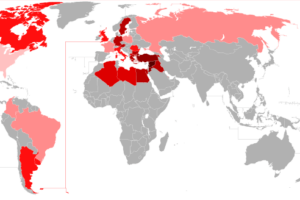
Syrian Refugees Per Capita: Who’s Been The Most & Least Generous
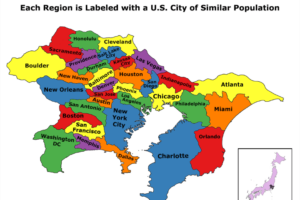
Population of the Metro Tokyo Area Compared To US Cities

World Toilet Paper Map Showing Spending On Tissue & Hygiene
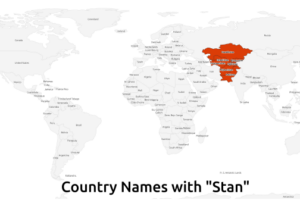
Why The United States Is A ‘-Stan’ Country Like Kyrgyzstan
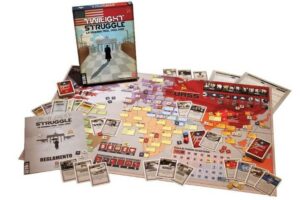
The 28 Best Map Based Strategy Board Games You’ve Probably Never Played

Scratch Map Giveaway: Win 1 of 3 Scratch Off World Maps From Landmass
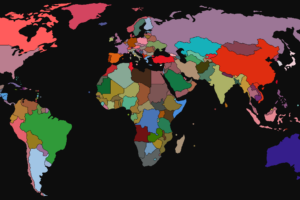
Average Colour Hue of Country & US State Flags
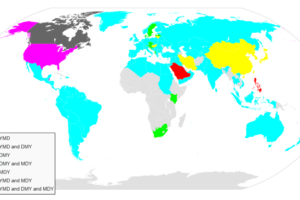
How To Write The Date In Different Countries
December 13, 2017 at 8:14 pm
I know that: a) it’s a bit of fun b) it’s hard to make a 2d map of 3d space and c) there no official maps to go off
But Christ, there’s a lot of stuff on here which makes no sense.
Justin Spaulding says
September 7, 2019 at 2:36 am
Isn’t gamma haromi 2 supposed to be in the haromi cluster…. Good effort though! S3. E8 I think. The “gatherers”
Danny Beans says
November 11, 2019 at 11:18 pm
Why are Ceti Alpha V and Ceti Alpha VI in completely different sectors? I mean, okay, Chekov can be a little dumb sometimes, but that’s one helluva mistake to make.
Jadziah Dax says
April 7, 2021 at 6:03 pm
Can’t wait to see the one you do!
petewinsemiusyahoocom says
November 23, 2022 at 3:47 pm
I agree, several planets said to be in the alpha quadrant are in the beta quadrant and vice versa or not listed at all.
Resolute_Phoenix says
February 8, 2018 at 11:41 pm
Okay so Xindus by Vulcan…. kys I’m not even gona bother looking further don’t make a map if you don’t know what your talking about
February 18, 2019 at 9:03 pm
Romulons should have Dyson sphere (at least at Romulus and Remus). Their ship tech is based on creating black holes which will give a ship a reactor core with a life of a handful of years BUT it’s just like an inefficient battery because it takes way more energy to initially create it then it will give off over its life BUT it’s portable. Sure beats light sails if your depending on home system energy and way more flexible too. This was their tech wheelhouse, and was their interstellar travel energy source instead of antimatter. It makes total sense for them to have harnessed the majority of their native suns energy to create reactor cores wherever they needed a portable energy that couldn’t tap into the system wide grid.
February 22, 2019 at 9:26 pm
A few questions… 1) Why are there several Indus VIII on the map?, 2) I do not see the First Federation on this map — they should be near the Ferengi!, 3) Where is the Kelvin planet? (The planet colonized by the Kelvins from “By Any Other Name”), 4) Maybe I’m wrong, but I do not see the Dyson Sphere that TNG crew ran into?
Shane Montgomery says
March 4, 2020 at 10:25 pm
I don’t see Barzan II or the Barzan Wormhole here?
Pickard says
January 23, 2021 at 3:39 pm
They are there. Literally the only Dyson sphere symbol near the bottom.
August 6, 2019 at 5:03 pm
Spock: He is intelligent, but not experienced. His pattern indicates two dimensional thinking.
Glenn Bryson says
November 15, 2019 at 6:52 pm
Not your fault, I know;
Vulcan is “Supposed” to be “A little over sixteen” light years from earth. Yet the map has it at around 1000. That’s one of my biggest gripes about Star Trek (I absolutely love Star Trek, don’t get me wrong). Distances and travel times are so inconsistent and unrealistic based on the documented scales, maps, etc.
March 14, 2020 at 11:46 pm
Did you mean Starbase 375 instead of 395? As in the starbase from S6 of DS9 after the Dominion took over the station?
Avro Arrow says
March 24, 2020 at 7:04 pm
I love this map, especially how you have the Hydran Kingdom, the Lyran Star Empire and the Kzinti Hegemony are listed (where is the Interstellar Concordium?). I have one small nit-pick to make and that is you have two systems named “Nelvana III”. They’re both in the upspin Beta quadrant but one is in the Romulan Neutral Zone and the other is further upspin and outward (left). I think that you might consider making most of the empty space that is coreward of Klingon and Romulan space into the ISC. They were referred to as being a Galactic Superpower residing on the far side of both those Empires (so, coreward).
Gray.Elton says
May 19, 2020 at 3:21 am
If we do or don’t do it, someone will laugh
July 15, 2020 at 1:53 am
I dont understand how this can be called a map of the star trek galaxy when there isnt even a spot or indication of where earth is. Who makes a map without earth when you have a series where its location is based on earth. In the series they refer to Earth as Earth. Yet the closes thing to it is on the map is Volcan. Y not add Earth as well? If there is an alternative name how come it’s never mentioned in the shows and a secret for fans?
Brandon says
August 15, 2020 at 4:14 pm
Earth is 100 percent there. It’s Sol. It’s a common alternate name for our star system and has been used in Trek.
February 8, 2021 at 3:26 pm
Sol system. The Greek word for sun. Follow the bold line and look for the team Terran and Vulcan sectors. Sol is on the 4 corners there
May 23, 2021 at 11:35 pm
Cheron is not in the Romulan sphere of influence. It is located in the “Southern most part of the Galaxy”, Captain Kirk. Episode “Let That Be Your Last Battlefield”
That dude says
September 6, 2021 at 5:31 am
Issues: Tykens rift, not Titans. Starbase 47 is about 10 sectors off as memory Beta says it is located between the Tholian assembly and the Klingon empire. Prophets Landing is in the gamma quadrant.
That’s all for now!
That Guy says
May 17, 2022 at 11:20 pm
Alpha Onias III is on here multiple times
John S says
November 16, 2022 at 4:31 am
Don’t the Klingon and Cardassian Empires border each other? A lot of DS9 s4 doesn’t make sense if they don’t…
martijn says
March 18, 2023 at 11:16 pm
where is earth ?
Leave a Reply Cancel reply
Your email address will not be published. Required fields are marked *
This site uses Akismet to reduce spam. Learn how your comment data is processed .
Screen Rant
Star trek's 4 quadrants & galaxy explained.

Your changes have been saved
Email Is sent
Please verify your email address.
You’ve reached your account maximum for followed topics.
Star Trek Actors & Executive Producers React To Peabody Award
5 star trek actors with real-life children in tv & movies, star trek returns to a ds9 & voyager location for the first time in 25 years.
Most of the action in Star Trek takes place in the real-world Milky Way Galaxy which is roughly divided into four quadrants, named after the first four letters of the Greek alphabet: Alpha, Beta, Gamma, and Delta. These are the galactic regions that include significant planets like Vulcan, Qo'noS, and of course, Earth. While Gamma and Delta still bear planets with ominous origins, the Alpha and Beta Quadrants are perhaps touched upon the most within the Star Trek mythos. Despite this common division, The Next Generation also referred to a new quadrant known as Morgana. But not much is known about this certain quadrant as it is not mentioned any further.
Even beyond the Quadrants, ardent Star Trek fans can spot the Galactic Barrier and several other celestial objects that are present in other galaxies like the Andromeda Galaxy (yet another real-world phenomenon) that are still yet to be explored more by the franchise's protagonists. While most of these galactic quadrants can be seen as astronomical phenomena rooted in scientific explanation, the mythos can also incorporate near-godly beings like the Sha Ka Ree in regions such as the so-called "Great Barrier." The two Barriers carry within them such heavenly mysteries that deserve explanations of their own.
TOS Invented Star Trek's Best Time Travel
Alpha Quadrant
The Star Trek galaxy explained that the Alpha Quadrant contains more than 60 home worlds, and this includes Captain Kirk's home planet Earth itself (which Trekkers would call Terra or Sol III). Other major planets include the Tellarite native planet Tellar Prime, Trill, which houses both the eponymous humanoid species and the non-humanoid Trill symbionts, and Betazed, which is inhabited by the Betazoids, a humanoid species that boasts warp-capable space vessels. Even though the majority of territories under the Klingon Empire and Romulan Star Empire fall in the Beta Quadrant, the two forces join the United Federation of Planets and the Cardassian Union to constitute the four great powers in the Alpha Quadrant in the late 24th century.
Beta Quadrant
The Star Trek galaxy explained that apart from the Romulans and the different versions of the Klingons , the Beta Quadrant's highlight is Vulcan, the native planet of Spock and other members of the Vulcan species. Multiple Star Trek encyclopedias suggest that Vulcan is located in a Sector of the same name within the Beta Quadrant. The 2002 publication Star Trek Charts also estimates Vulcan's exact position to be somewhere in the 40 Eridani star system that really exists 16.3 light years from Earth's Sun. Much like Spock, the inhabitants of Vulcan can be identified with their raised eyebrows and pointy ears. Mostly devoid of emotions, the Vulcans are known for leading a life on the basis of logic and reasoning.
The Klingon homeworld Qo'noS and the Romulan Empire's native planet Romulus also fall under this galactic quadrant. The former has a chaotic weather system with frequent thunderstorms and a rocky landscape characterized by numerous dormant volcanoes and caves. The native warrior species of Klingon are bound by their martial traditions and value honor in combat. As for Romulus, the planet served as the second home for Romulans ever since they migrated from Vulcan. The biological cousins of the Vulcans, they had to move back to their original homeworld after Romulus' sun exploded in 2387. According to The Next Generation , Risa is also a part of this quadrant. Known as the pleasure planet, Risa is known for its sexually liberated culture.
Gamma Quadrant
The Star Trek galaxy explained that the Gamma quadrant includes several Star Trek planets such as Brax, Yadera, Meridian, and others. As seen in Deep Space Nine , the Quadrant also houses the Dominion, an aggressive ensemble of several alien species commanded by the shape-shifting Changelings (AKA the Founders). Several territories of the quadrant are under the Founders' control even though they have had only two home worlds. The first home world of the Founders was a rogue planet that housed the Founders who were, at that time, escaping prosecution from the "solids" (how they referred to non-shape shifters). By 2372, the Founders shifted to a second home world.
Related: Star Trek - Spock's Entire Prime Universe Timeline, Explained
Delta Quadrant
The Star Trek galaxy explained that Star Trek: First Contact confirms the origin of the Borgs from Delta but doesn't name their home planet. This is the case for many other species of Delta, a quadrant that is relatively unexplored by the United Federation. Only Voyager offers the most details about the planets within the quadrant. Delta is also known as the domain of antagonistic species like the Borgs, the Kazon, and the Vidiians. The cybernetic Borgs are mostly linked through a hive mind known as the Collective. As for the Kazon, they are nomadic in nature which makes it difficult to trace their planet. Vidiians are similarly migratory and sport-scarred faces as a result of the terrible Phage pandemic.
The Galactic Barrier
The Star Trek galaxy explained in the original series what is known as Star Trek 's Galactic Barrier . In the subsequent years, Trekkers have called it by many names ranging from Great Barrier to the Energy Barrier, but there is still much debate and discussion regarding the origin of this energy field that surrounds the Milky Way Galaxy. The origins behind its creation are still hotly debated so it is uncertain whether the Galactic Barrier was created by a natural process or by artificial means. Most of the conventional spaceships that have tried crossing this barrier in the Star Trek universe have often been destroyed with the crew even gaining psychoactive traits while nearing the barrier.
The Andromeda Galaxy
Progressive exploration of the Star Trek galaxy explained that the Milky Way Galaxy is definitely not the final frontier , as several other galaxies lie beyond it, such as the Andromeda Galaxy. This serves as a home for the planet Kelva, the capital of the Kelvan Empire. The Kelvans are highly intelligent shapeshifters. Because of their intellectual superiority, the Kelvans feel that it is their duty to rule over other species. The same galaxy also includes the humanoid species simply known as the Makers, creators of service robots and outposts in both the Andromeda and Milky Way Galaxy. The outposts were a residential necessity given how a supernova had destroyed their homeworld.
The Extragalactic Species
The Star Trek galaxy explained that the spanning areas of planets and species that border Star Trek 's Galactic Barrier from the galaxies beyond the Milky Way are still vague in Star Trek canon. Still, some information has been obtained on a few humanoid and non-humanoid extragalactic species. Species 10-C is a major case in point. A highly-advanced non-humanoid race with members much larger than humans, the species is responsible for creating the heavily destructive Dark Matter Anomaly. With their bodies adapted to float in gas layers, Species 10-C belong to a homeworld near the Galactic Barrier. Other such examples of extragalactic species include the "space amoeba" Nacene, the physically fragile Ornithoid, and immortal races like the Q and the Douwd.
Related: Star Trek Just Created A Second 25th Century Timeline
The Center Of The Galaxy
Star Trek V: The Final Frontier reveals the presence of the mythological planet Sha Ka Ree right at the center of the galaxy that doesn't fall under any quadrant. An equivalent of the concept of heaven, Sha Ka Ree is regarded in Vulcan mythology as the realm of all creation. But owing to humankind's fear of exploring the unknown and the second Galactic Barrier, the exact physical nature remains unexplored and is regarded as a mythical entity. It goes to prove how the mysteries of Star Trek 's chief galaxy don't just go beyond its exterior but its very core too.
Multiple Alternate Realities And Timelines
Not only is there several quadrants, but the Star Trek galaxy explained that there are also several alternate timelines in the franchise's world. In the Paramount+ series Picard , there is an alternate reality that completely rewrites Star Trek's history . The movies, from the original series to the Next Generation, take place in what is known as the Prime Universe. The J.J. Abrams movies take place in what is known as the Kelvin Timeline.
Abrams showed this in his movies by having the Kelvin Timeline Spock meet a Spock from a different timeline. This allowed Star Trek to move on with any story it wanted to tell by explaining the characters are from different timelines with new and fresh histories. There is also a Mirror Universe, an alternate timeline ruled by the fascist Terran Empire instead of the Federation. With so many quadrants, they all likely ended up very different in each timeline, making the Star Trek stories endless.
More: Why TOS Never Got A Series Finale Until Star Trek VI
2.1.1 The subdivision of the Galaxy
While in our time, we haven't ventured deep enough into space to need other systems for the exact determination of positions within our incredibly large galaxy than the equatorial and galactic coordinate systems, in the world of Star Trek, in which the interstellar navigation is the basis of trade, politics and the everyday life of billions of people, a further subdivision of space is used, beside the much two large division into "galaxies" and the much two small division into "planetary systems" - the subdivision into quadrants and sectors. These two terms, whose meaning was quite contradictious at the beginning, but has been exactly fixed in the meantime, have become a basic element of the space navigation shown in Star Trek through the years, since with the sector and quadrant system, a certain place can be quite precisely localized, without using a complicated coordinate system.
1. The four quadrants
Already in the era of Classic Trek, the expression "quadrant" was used for the exact determination of positions in the Star Trek universe. However, this cartographic term which literally refers to "a quarter" was used for completely different three-dimensional volumes at that time: sometimes a quadrant indeed corresponded to a quarter of the galaxy, but all too often it also denoted considerably smaller regions. In this connotation, the size of a quadrant rather corresponded to the size of a sector, like the designation "quadrant 904" in [TOS] The Squire of Gothos indicates. Up to the beginning of The Next Generation and also in the first movies the "quadrant" wasn't defined unambiguously and was used contradictorily. Finally in Star Trek VI, the current - and correct - quadrant system was introduced, according to which "the galaxy is subdivided into 4 quadrants, from which each forms a 90 degrees piece of cake, viewing the galaxy from the top or the bottom" (Star Trek Encyclopedia). An insider information on this movie even implies that the system was mainly introduced to justify Captain Sulu's claim that "he is in the Beta quadrant and currently the only Star Fleet ship in the quadrant."
Even a subspace transmission (warp 9.9999 with amplification) covers this distance in more than three months. Consequently, only the fact that Earth, the Federation and most of the other empires are located at the frontier between Alpha and Beta quadrant makes it possible that we hear something about other quadrants at all, and it isn't surprising that the two remaining quadrants - Gamma and Delta - were not explored until the era of DS9 and Voyager started, and then only with "tricks" like wormholes and intergalactic displacement waves.
2. The sectors
In contrast to the quadrants, space sectors, that are mentioned in nearly every episode (remember sector 001 - the solar system), are an astronomically small division of the galaxy and therefore more useful for the exact determination of positions in Star Fleet's everyday life - what explains their often use (although, however, in the recent seasons of Voyager and DS9 the Alpha Quadrant was mentioned in every second episode). Because the dimensions of a sector are, in contrast to the quadrants, not important for the episodes and this subdivision was always used for space regions of small scale, it isn't astonishing that the official definition was not determined "first hand" in a episode or movie (not even as background information), but in an official documentation.
At any rate, a sector is apparently not a natural, but a artificial, systematic subdivision of the galaxy into smaller space regions, what is also supported by the Encyclopedia, which suggests that "a typical sector in Federation space contains 6-10 planetary systems, although there are many more in the sectors near the Galactic core." Therefore, Sector 001 should not only contain the solar system, but also e.g. the Wolf and Alpha Centauri systems.
Just as the quadrants, also the sectors have some irregularities in their designation, but that's acceptable in this case, because of the sector numbering system of the Federation, we only know the starting point (sector 001), but not the direction of the numbering, and the situation of the numbered sectors introduced in different episodes towards each other is unknown. However, it is very likely that in view of the centuries of space exploration and already different designation systems today, the system of the Federation is contradictious itself and the sectors are numbered more or less arbitrarily. It is also possible that the sector numbers, like the registry numbers, were assigned to newly discovered space regions at entirely different locations in space with increasing sequence, and the sector system accordingly has a chronological order.
The Star Trek Encyclopedia suggests that "some sectors kept their old designations from earlier cartographing systems the same way as we use today both the older Messier and the newer NGC numbering system." In fact, some sectors apparently haven't a number at all (like the Igo Sector and the Bajoran Sector); they were named after the dominating planetary system or most important star in the sector.
2.1.2 The political division of the Galaxy
Already the mere space explored by humanity - about 5000 ly on both sides of the Alpha/Beta Quadrant border, at which Earth is located, there are six closely adjoined interstellar alliances and empires - Federation, Romulan Star Empire, Klingon Empire, Cardassian Union, Breen Confederacy, the Tholian Assembly and a dozen other important powers such as the Ferengi, Trill, Talarians, Tzenkethi and Gorn. However, actually solely the United Federation of Planets with 150+ member planets, numerous Federation protectorates and hundreds of colonized planets, which are scattered over 8000 ly and distributed to several agglomeration areas ("cores"), is large enough to be visible on an overview map without exaggerated dimensions. Beside the Federation, the sole super power in the (known) lower part of the Milky Way, however, there are more comparably large or even larger powers in the upper half: the Dominion in the Gamma Quadrant, which takes up a whole part of the Sagittarius arm of the Milky Way, and the Borg Collective, which core region has a perhaps five times as large volume than the Federation has, but whose sphere of influence extends over the half Delta and Beta Quadrant. There are still other powers in the Galaxy, but which do not owe their large territories to their political status (like the Federation as a loose, not necessarily spatially joined interplanetary alliance) or their superiority to other species in numbers or technology (like the Borg or the Dominion), but to other factors, which effect the extension of their empires. For example, the Krenim belong(ed) to the dominating super powers in the Delta Quadrant with almost a thousand planetary systems solely due to alterations of the time line, which enlarged their empire and finally made it smaller again. On the other hand, the Hirogen dominate a larger area of space despite their slow ships because of the nomadic way of life which is typical for them - they restlessly travel around to hunt their prey. The Turei inhabit a larger part of the lower Delta Quadrant, because they have access to the sophisticated subspace corridor system of the Vaadwaur. In the end, most peoples have too little influence on other empires or a too less established territory to be called a super power, so that the number of interstellar important alliances is very limited. Finally, the exact political subdivision of the Galaxy remains unknown, because our knowledge is sketchy at best. Only some small parts of the Alpha, Beta and Delta quadrants are known, in which nonetheless the territories of more than a dozen powers are located. The Gamma Quadrant could be explored merely four years, until the Dominion - the sole power known in this quadrant - prevented this. Consequently, there is enough space in the Milky Way for hundreds of interstellar alliances and empires, which could be discovered already with the next deep space mission - the Cytherians, which apparently populate a huge part of the galactic center, are only one example.
After this summarizing introduction in the general subdivision of the Milky Way and the political situation in the Galaxy, now the time has come to immerse in the Star Trek Galaxy and to examine the most important planetary alliances and empires, their location, structure, formation and development more elaborately, starting with the United Federation of Planets.
� 1999-2001 by Star Trek Dimension / Webmaster . Last update: April 27th, 2000
Everything You Need To Know About The Star Trek Quadrants
- Last updated: 28 Apr, 2023
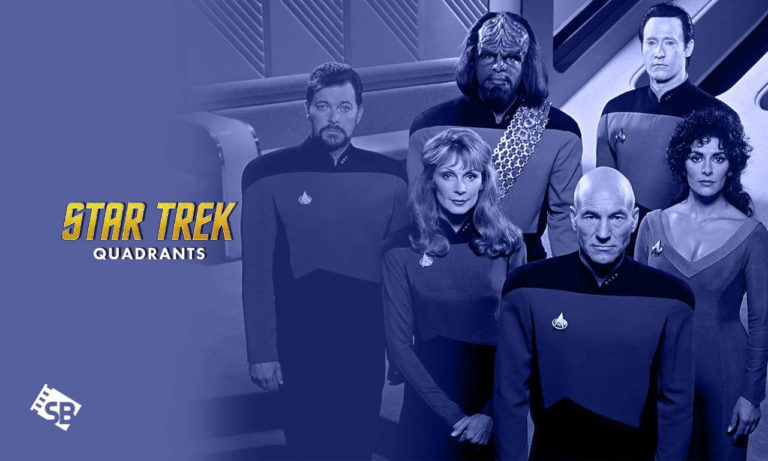
Table of Contents
What Is A Star Trek Quadrant?
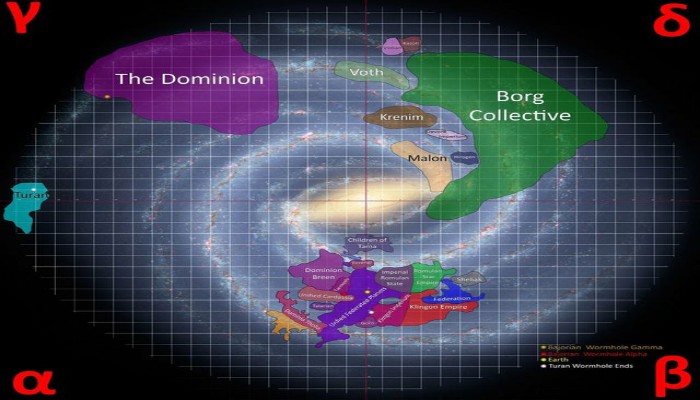
According to the Star Trek Quadrants map in the universe, the “galactic quadrants” are defined by an imaginary meridian that runs across our solar system, which is similar to the concept employed by astronomers.
Instead of going via the Sun as in astronomy, the perpendicular axis in the Star Trek map of quadrants goes through the galactic center.
Accordingly, Star Trek’s quadrant system is less geocentric than normal cartography. In addition, the Greek letters Alpha quadrant star trek, Beta, Gamma, and Delta are used to denote them in the Star Trek galaxy map rather than ordinals, as in the movies.
Star Trek Quadrants Explained
Background Of The Star Trek Quadrants?
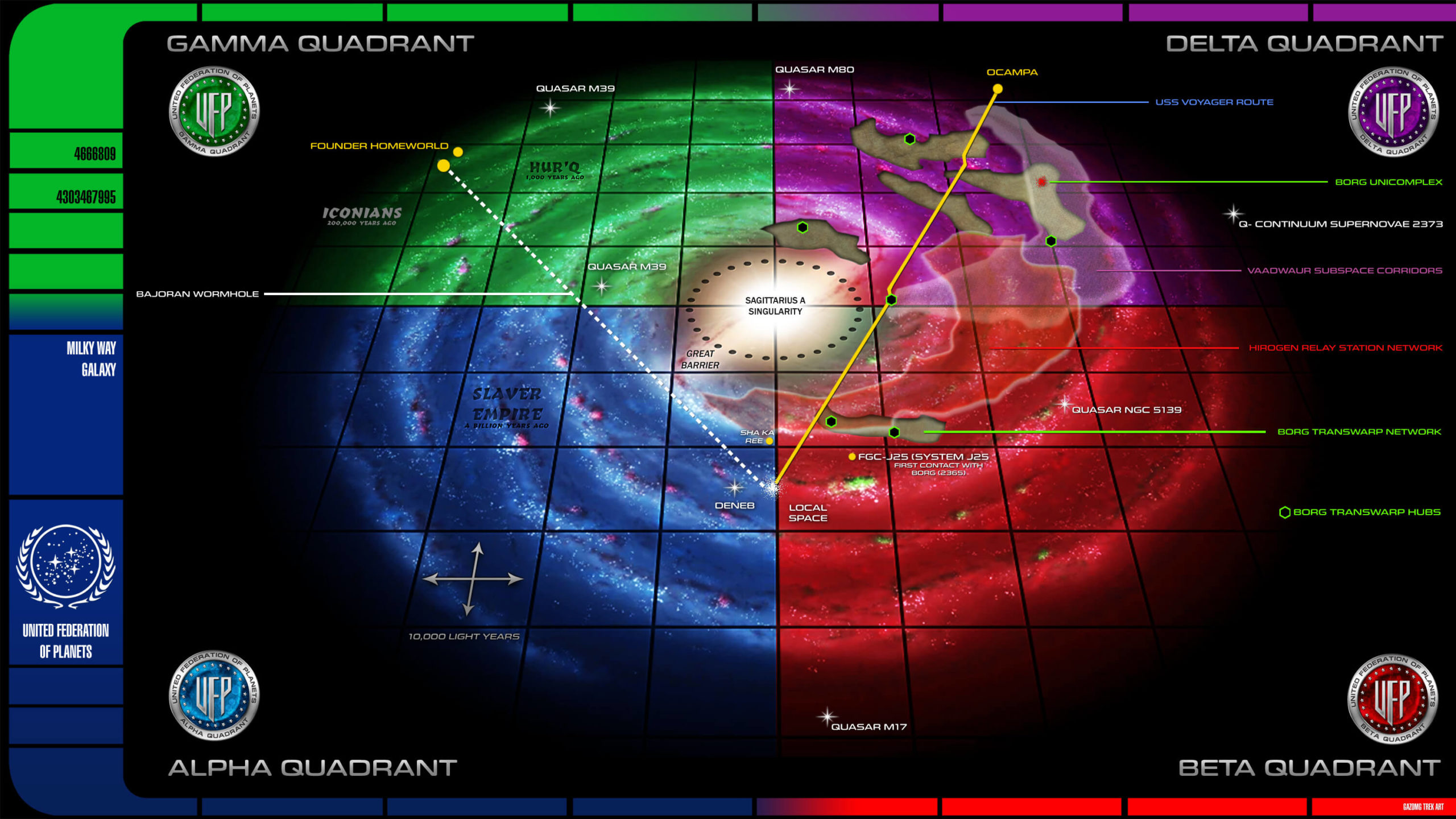
To prepare for the invasion, trans-dimensional entities in the Expanse erected cloaked moons in the area . Their objective was to change the fabric of space in the region, making it hospitable for the Sphere Builders thousands of years ago.
Within a cluster of spheres 700 million kilometers in diameter , a portion of the Expanse has already been transformed into a boiling, organic-looking soup of subatomic particles. One or more spheres provide a command function for the network, which uses artificial intelligence.
As they are hidden, the actual number of spheres is unknown. Thousands of spheres, according to Trianon’s belief. They concluded that there were at least seventy-eight spheres on the star trek Galaxy map and that Degra was one of them.
The Expanse is referred to as the “Chosen Realm” by the Triannons, and their religion is based on the spheres and their mythology. After being stranded in 2037, the spaceship Enterprise from 2154 becomes a generational ship, devoted to fighting the Xindi menace that will emerge in 2150.’s future.’
In 2133, a party of Klingons ventures into the Expanse, only to return anatomically flipped (and still alive). Vulcan ships Seleya and Vaankara also try to investigate the area without success.
The crew of the Seleya, who had been exposed to Trillium-D, were found to be insane and consequently exterminated. Earth’s Starfleet ship Enterprise (NX-01) enters the Expanse in roughly June 2153 in an attempt to find the Xindi.
Later in the year, the Andorian ship Kumari joins the fleet. Reverting twisted space to its original shape and progressively dissolving the thermobaric cloud barrier, the Enterprise destroyed the network of Spheres on F ebruary 13, 2154.
As a result of this, the Expanse fades away into obscurity. Even though a scenario is given to Captain Jonathan Archer of the Enterprise in which the Expanse becomes a significant danger to the future United Federation of Planets , this certainly seems to be removed by the effective destruction of the Spheres. The galaxy is commonly divided into four quadrants, the Alpha Quadrant, the Beta Quadrant, the Gamma Quadrant, and the Delta Quadrant which can be seen if you watch Star Trek movies in order .
Star Trek: The Major Quadrants
According to common belief, the Milky Way Galaxy is divided into four equal-sized cubic quadrants, each defined by a meridian that passes through the galactic center and a second meridian that runs perpendicular to the first and goes through the galactic core.
The four quadrants of the equilateral triangle are known as the Alpha Quadrant, Beta Quadrant, Gamma Quadrant , and Delta Quadrant in mathematics.
The Alpha and Beta Quadrants , respectively, were dominated by alliances with the United Federation of Planets and its bordering powers, such as the Klingon and Romulan Empires.
The Borg Collective and the Dominion , on the other hand, were centered in the Delta and Gamma Quadrants, respectively.
The cosmos appeared to cease to exist for a brief while in the year 2267 when Lazarus and anti-Lazarus began switching places with one another.
Captain Kirk correctly noted in his report that the effects could be felt across the whole quadrant of space. According to Starfleet Command’s Commodore Barstow, afflicted areas covered every quadrant of the Galaxy and far beyond.
Alpha Quadrant
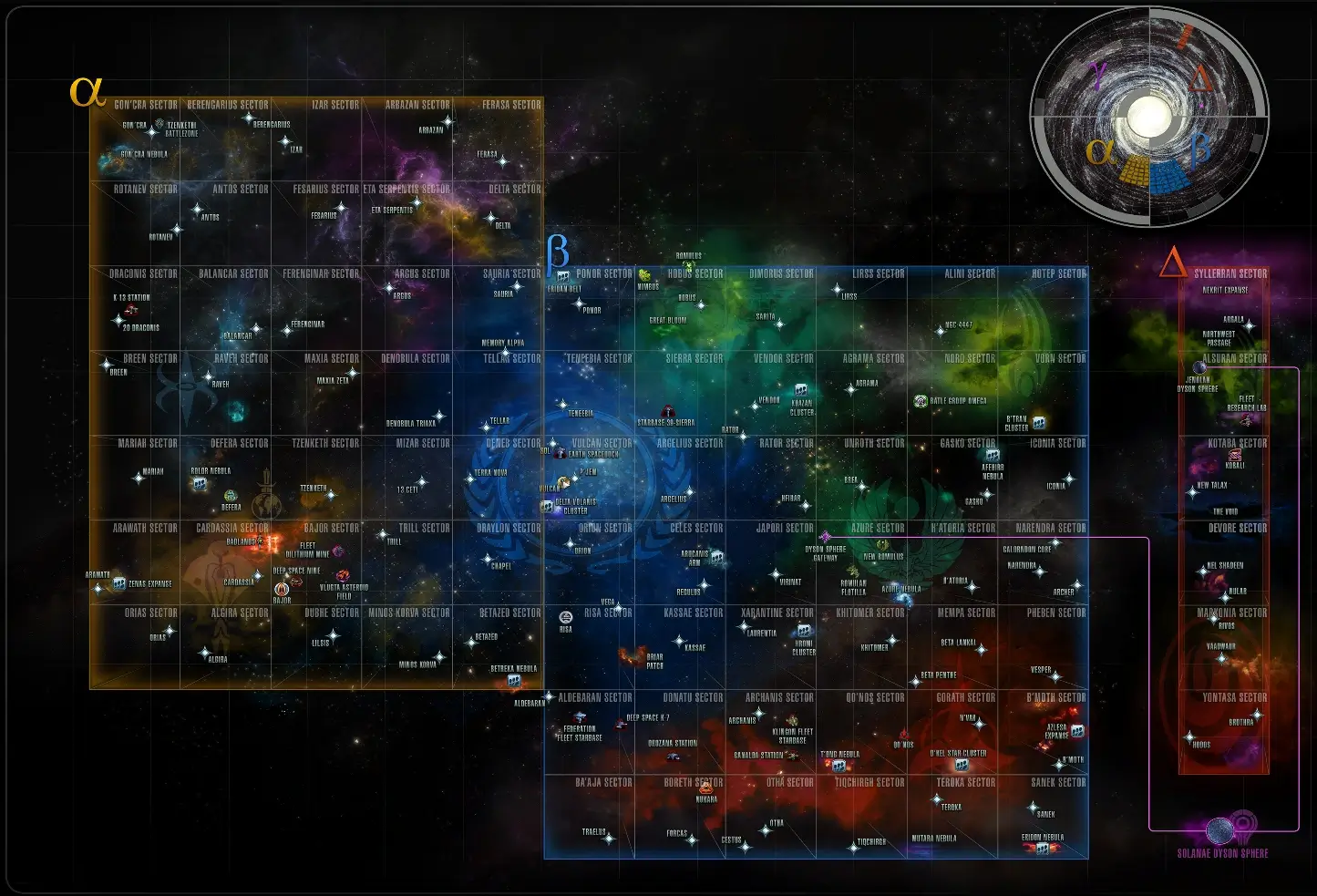
Except for Voyager and Deep Space Nine, the bulk of the franchise’s episodes take place inside the Alpha quadrant of Star Trek of the Galaxy. The planet Earth and a substantial section of the United Federation of Planets may be found here.
Because the planet Earth is situated inside this sector, the great majority of the journey conducted by starships seen in television shows and films takes place within this quadrant.
The Star Trek quadrants, on the other hand, are not bound to a certain area of the Galaxy. This seems to be among the most well-known spot on the face of the planet.
The planets of Trill, Tellar, and Betazed may all be found in this quadrant, along with our solar system, which makes up the whole quadrant.
Some claim that the Alpha sector contains remnants of the Romulan and Klingon civilizations , while others assume the opposite.
Beta Quadrant
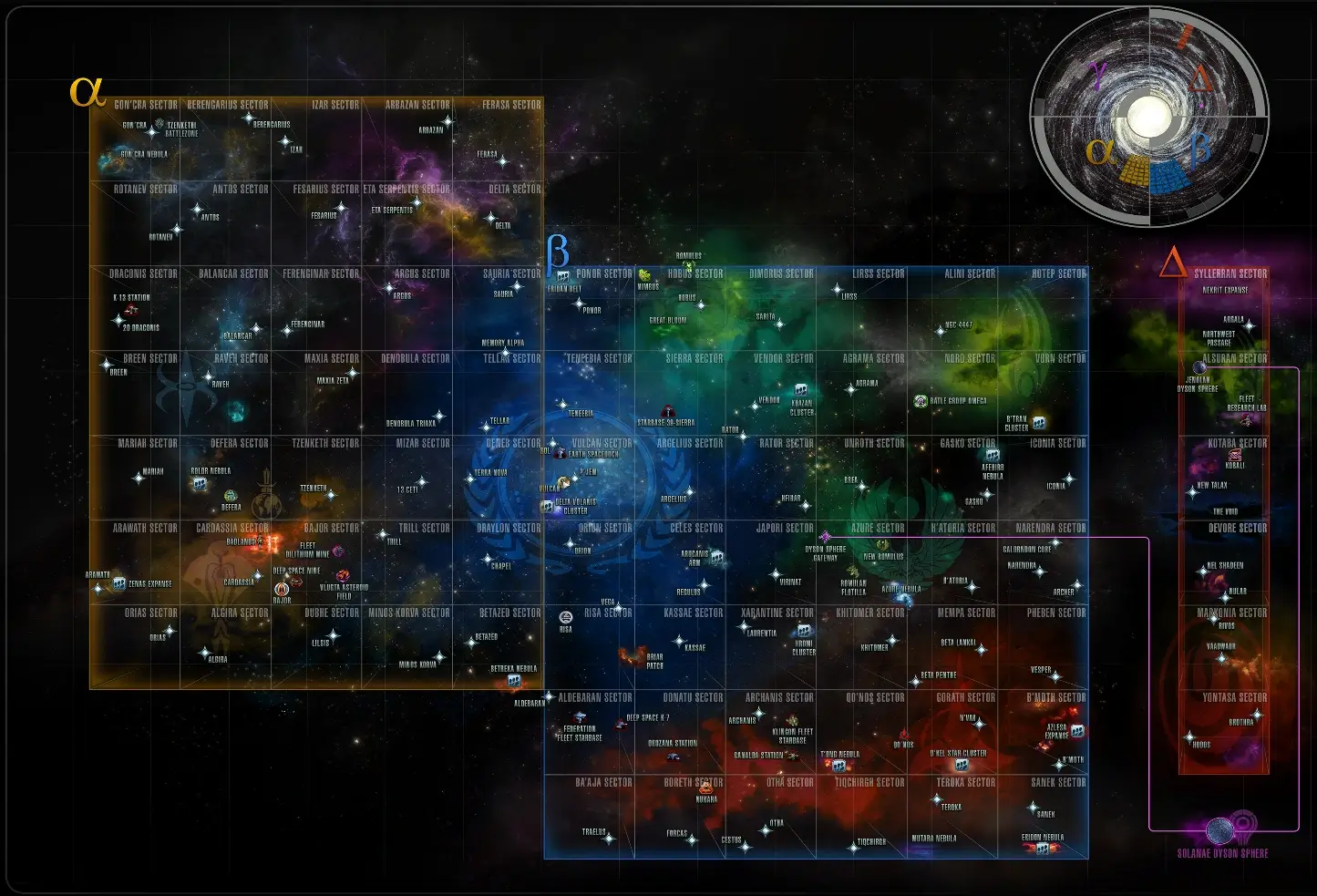
The Beta quadrant contains the rest of the Federation, much as the Alpha quadrant does. This implies that similar to Alpha, many television episodes and movies are set in this sector of the Galaxy.
The vast majority of the Romulan and Klingon empires are concentrated in this area. Beta is also home to Andoria, Risa, Vulcan, and Rigel. Certain publications claim that the Romulan and Klingon empires are entirely contained to a Beta quadrant and do not cross into the Alpha quadrant. These sources are incorrect.
Gamma Quadrant
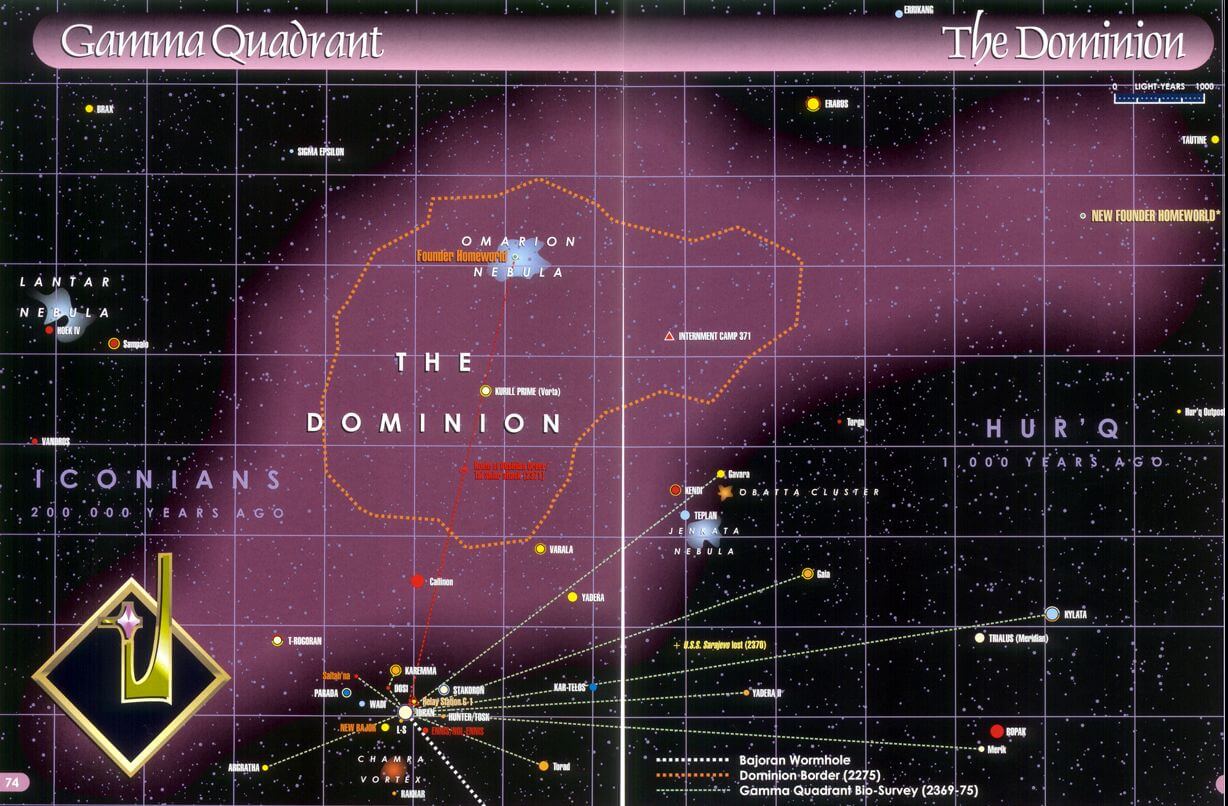
The Star Trek Gamma quadrant was only partially explored until a wormhole was found in the Bajor area in the Alpha quadrant, which allowed for more extensive exploration.
It made it possible for individuals from Alpha to get to Gamma without having to spend years and years traveling.
The Federation was able to communicate with the Dominion via this wormhole, which was dubbed the Bajoran wormhole by the Federation.
This is the foe that we come up against in the television series Deep Space Nine . They are also in charge of the wormhole, which they created.
Delta Quadrant
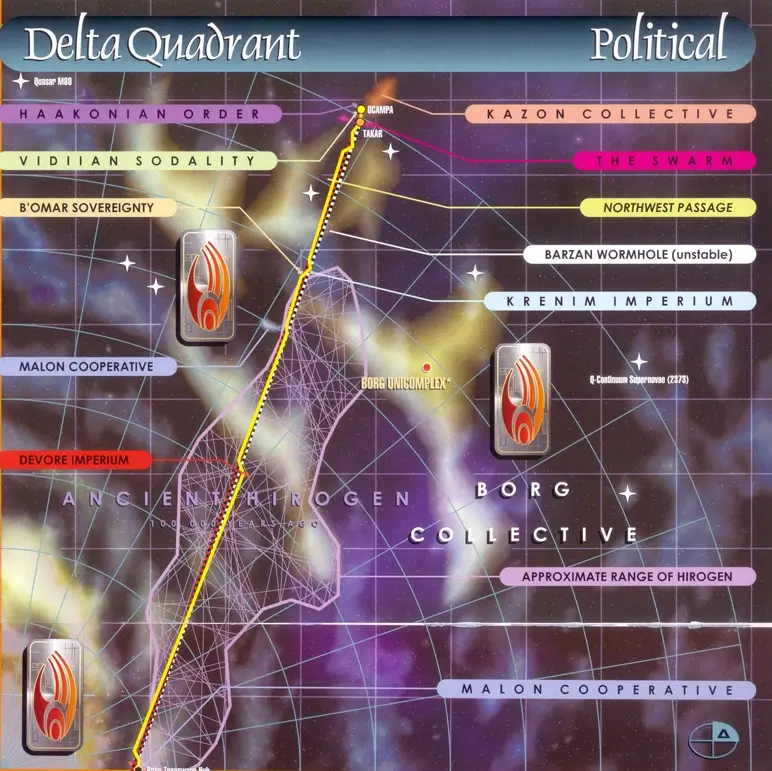
Most of the galaxy’s Delta Quadrant area has gone mostly undiscovered. Reliving their routes back to Earth took the crew of the USS Voyager years to complete.
Return to the beginning location by drawing a straight line from the Alpha and Beta quadrants.
Before the Borg landed in the Delta quadrant, this part of the Milky Way was widely considered to be the home of the Borg. Voyager discovered when returning to Earth that it’s also the homeland of the Kazon, Vidiians, Hirogen, and Species 8472.
Star Trek: The Minor Quadrants
During the 23rd and 24th centuries, smaller parts of space in the Galaxy were called quadrants, which were smaller sections of space inside the Galaxy. Among them were the Quadrant 9, Quadrant 448, Quadrant 904, the Morgana Quadrant, and the Drema Quadrant.
Quadrant 9 is a geographical location in space . This quadrant included a part of the Neutral Zone, which was positioned far enough from Ferengi Alliance territory and protected from attack. As of 2364, there has been no recent evidence of Romulan activity in the area.
Quadrant 448
Quadrant 448 was the site of a renegade comet that had just passed through Gamma Hydra IV in 2267 , according to Stardate 2267 .
Before the present standardization of the quadrant/sector paradigm of celestial cartography, the word “quadrant” refers to a region of the sky.
Quadrant 904
Quadrant 904 was in space in the Milky Way Galaxy, home to several planets. There was a star desert to be found in this area. According to the most recent known data, when the USS Enterprise was first seized by the planet Gothos in this position is 2267, the ship was eight days distant from the planet Beta VI at warp factor three, and Earth was nine hundred light-years away. The Quadrant 904 Central Station served as an embarkation point and a destination for commercial transportation in 2328.
Morgana Quadrant
As per MemoryAlpha , in space, the Morgana Quadrant was a geographical location. Uncrewed Federation ships have already sailed through this area in the early years of the twenty-first century .
During a star-mapping mission that year, the USS Enterprise-D was going to the Morgana Quadrant when it met the lifeform known as Nagilum, a first for the Enterprise-D.
The Enterprise-D was the first human Federation vessel to explore this region when it arrived in 2254 .
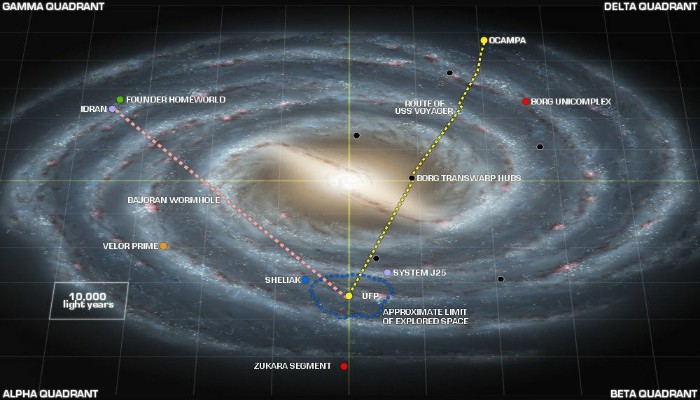

Wrapping Up
In the science fiction television series Star Trek and its spin-offs , a galactic quadrant is a region of the Milky Way Galaxy explored.
The original Star Trek helps to allude to a region that could be interchanged with a sector. Star Trek: The Next Generation and its spin-off programs and films, on the other hand, relate to a system of four galactic quadrants, denoted by the Greek letters Alpha, Beta, Gamma, and Delta in the original series. Each quadrant may be subdivided into sectors, which can be further subdivided.
It’s difficult to estimate the true extent of Star Trek Quadrants because of the large number of variables involved. The human characters in the series have explored a tiny portion of the world.
On the other hand, they have encountered races of aliens that have journeyed around the cosmos, so enlarging it for them. Hopefully, this article has given you a better understanding of exactly how large the Star Trek universe is and how we came to know about it.

Joshua calls himself nerd+geek who is also passionate about rugby. He enjoys comics, animes, and science fiction. He finds his comfort in writing about suspense, thrillers and science fiction shows and movies.
Leave a Reply Cancel reply
Your email address will not be published. Required fields are marked *
- Movies & TV
- Big on the Internet
- About Us & Contact
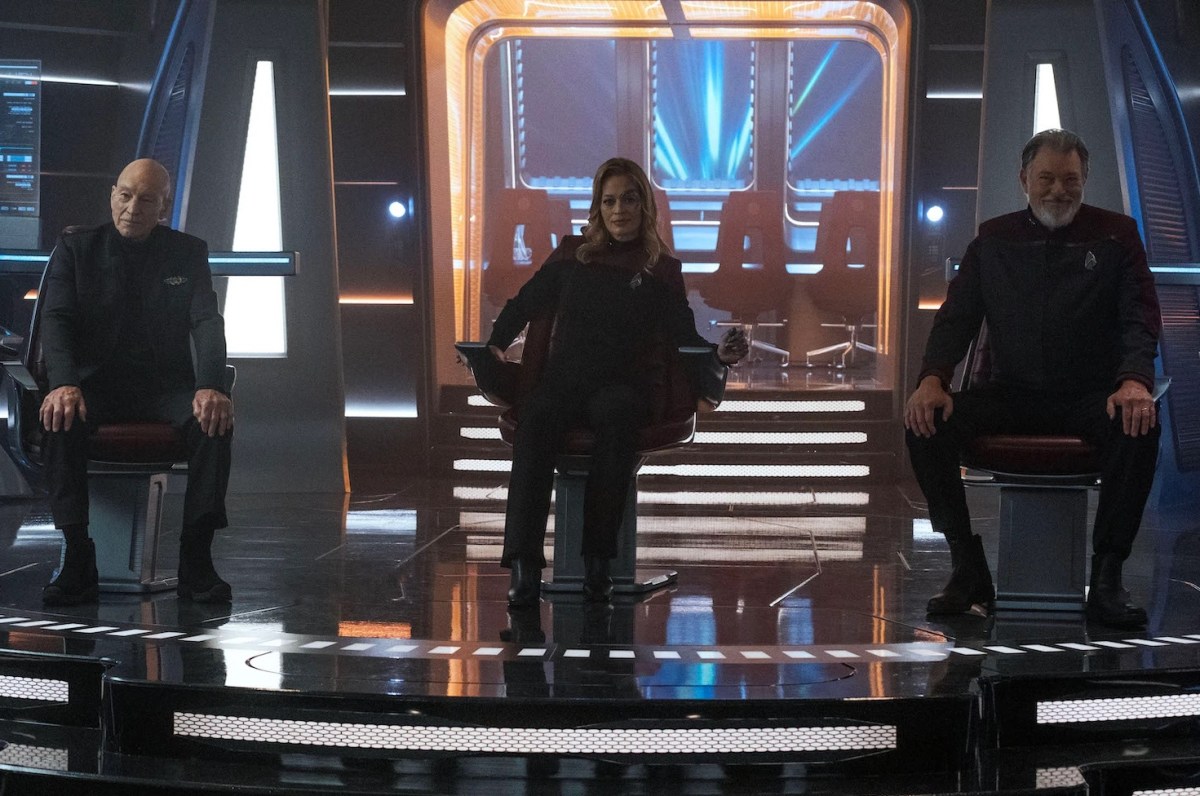
A Wannabe Blue Shirt Officer’s Guide to the Map of the Galaxy in ‘Star Trek’
No matter the fictional universe— be it fantasy or sci-fi or somewhere in between (looking at you, space operas)—I’ve always found maps and cartography one of the most fascinating parts of worldbuilding. There’s something about actually seeing how an author imagines the setting of their story that immediately grounds it in the realm of possibility, and helps immerse viewers in the worlds in which these stories unfold.
Sure, it’s somehow easier when the map consists of a single continent, kingdom, or city on Earth or any other Earth-like location. Bringing the action up into space definitely makes everything a tad more complicated—and a whole lot more fascinating.
And now that the third season of Star Trek: Picard is in full swing , there’s no better time to refresh our collective memory on the “astrogeography” the crews of the USS Enterprise explore.
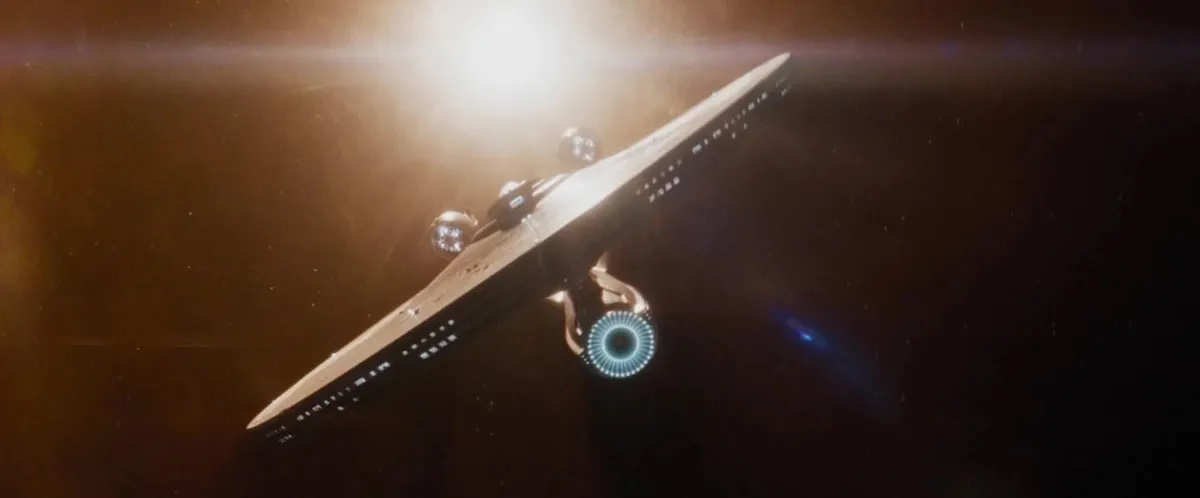
Star Trek and maps
The decades that have passed since Star Trek first premiered on television screens have made it possible for the saga to acquire beautifully complex and detailed lore on pretty much everything related to it—including the planets that make up the United Federation of Planets, and the powers that border it, like the infamous Klingon Empire.
There have actually been several maps made for Star Trek and its locations over the years, as it reads on The Map Room blog . “While original series canon assigned aliens to known nearby stars, and the shows occasionally used real locations, episode writers did not start with a map and generally did not take spatial relationships into consideration, which no doubt has made the belated mapping process a bit more challenging,” The Map Room blog continues, explaining how creating a comprehensive map of the Star Trek galaxy might be easier said than done.
Still, while none of the maps ever put to print or screen have ever been accepted as official canon, most of them have the major power players of the galaxy in more or less the same location. This means we can reasonably assume that this is the actual position in which they can be found in-universe.
The galaxy quadrants
Most of the action in the Star Trek canon takes place within our galaxy, the Milky Way, which has been divided into its famous four primary quadrants, each named after a letter in the Greek alphabet: Alpha, Beta, Gamma, and Delta.
The Alpha and Beta quadrants are the ones that are better known, even in-universe, and that house many of the major players we see throughout the various series—the United Federation of Planets chiefest of all. The Federation has a strong foothold in both quadrants, spanning Alpha and Beta from their shared border outwards.
According to Memory Alpha , the official Star Trek fan wiki, the Alpha quadrant contains two all-important planets that we all know very well: Earth, from which a good majority of the characters in Star Trek canon hail; and Vulcan, the homeworld of the Vulcans and especially of Spock. This quadrant also contains the Cardassian Union, the Ferengi Alliance, and the Breen Confederacy—among other smaller factions—whose representatives make an appearance in the canon, particularly in Star Trek: Deep Space Nine .
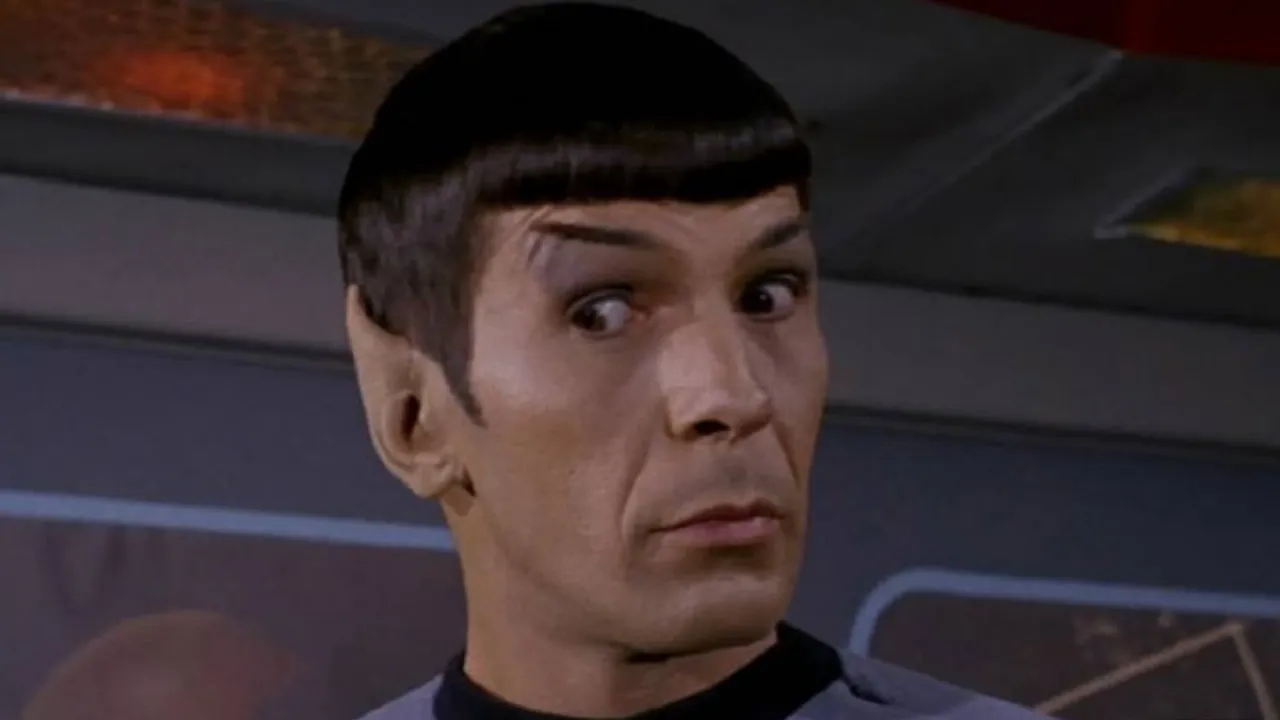
The Beta quadrant includes a couple of relatively smaller players like the Nyberrite Alliance and the Tholian Assembly, and then the major forces of the Romulan Star Empire and the infamous Klingon Empire—who both have their respective homeworlds, Romulus and Qo’noS, in this quadrant.
In contrast to the Alpha and Beta quadrants, the Gamma and Delta quadrants are considerably less well-known and less visited—which makes sense, considering the notable distances that separate them from the other areas of the galaxy, which would require years to bridge even at warp speed. Their reputation also isn’t as stellar as the areas in Federation space.
Still, they are of course mentioned time and again in the canon, as are the planets and people located within them. The Delta quadrant, for example, is the place of origin of the infamous Borg Collective, made up of the terrible Borg cyborgs.
(featured image: Paramount+)

Beta Quadrant

Astrometric Data
Part of the United Federation of Planets was located in the Beta Quadrant, along with the bulk of the Klingon and Romulan Empires, including their homeworlds of Qo'noS and Romulus.
Ore Locations
**please note that the ore required to create Tiered Tech Components is not listed and will need to be explored to find its location
Transwarp to Delta Quadrant
Memory Beta, non-canon Star Trek Wiki
A friendly reminder regarding spoilers ! At present the expanded Trek universe is in a period of major upheaval with the continuations of Discovery and Prodigy , the advent of new eras in gaming with the Star Trek Adventures RPG , Star Trek: Infinite and Star Trek Online , as well as other post-57th Anniversary publications such as the ongoing IDW Star Trek comic and spin-off Star Trek: Defiant . Therefore, please be courteous to other users who may not be aware of current developments by using the {{ spoiler }}, {{ spoilers }} OR {{ majorspoiler }} tags when adding new information from sources less than six months old (even if it is minor info). Also, please do not include details in the summary bar when editing pages and do not anticipate making additions relating to sources not yet in release. THANK YOU
- Memory Beta articles sourced from games
- Memory Beta articles sourced from reference works
- Memory Beta articles sourced from episodes and movies
- Memory Beta articles sourced from video games
- Memory Beta articles sourced from novels
- Memory Beta articles sourced from novellas
- Astronomical regions
- Milky Way Galaxy
- Alpha and Beta Quadrant
Alpha Quadrant
- View history
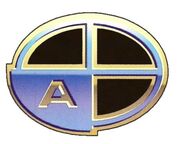
Locator logo insignia showing the galaxy 's Alpha Quadrant .
The Alpha Quadrant is one of the four quadrants of the Milky Way Galaxy , and lies in the "south-west" region of the galaxy map.
- 1.1 Races and cultures
- 1.2 Scientific phenomena
- 2.1 Connections
- 2.2 References
- 2.3 External link
History and specifics [ ]
Races and cultures [ ].
The Alpha Quadrant is home to a number of major and minor political entities including the United Federation of Planets , whose headquarters is located on Earth on the border with the neighboring Beta Quadrant . Most of the Federation's member planets are located in the Alpha Quadrant, including Betazed , Deneva , Bolarus , Trill , and Benzar . In its entirety, the Federation spans over 8,000 light years in both the Alpha and Beta Quadrants.
The Federation's biggest ally, and one time enemy, the Klingon Empire , also occupies a few systems in the Alpha Quadrant, but its largest sphere of influence is the Beta Quadrant. [ citation needed ]

Map showing an angle of Romulan expansion into Alpha Quadrant.
Another Beta Quadrant government , the Romulan Star Empire , holds some key territory in the Alpha Quadrant, including a frontier that borders the space of the Breen . ( Last Unicorn RPG module : The Way of D'era: The Romulan Star Empire )
Some smaller powers in the Alpha Quadrant include the Orions , the Tholian Assembly , the Breen Confederacy , the Gorn Hegemony , the Tzenkethi , and the Ferengi Alliance . However, one of the largest political entities in the Alpha Quadrant is the Cardassian Union .
Situated in Sector 45833 , bordering the Bajoran sector , the Cardassians occupy a large number of star systems and planets, and also shares borders with the Ferengi and the Breen. Throughout the 24th century , relations between the Cardassians and the Federation have often been strained with the Federation-Cardassian War between the 2340s and 2360s , though that war was ended in 2366 and the two worked towards a tenuous peace. ( ST reference : Star Charts )
That peace ended in 2373 , when the Cardassians entered into an alliance with the Gamma Quadrant 's Dominion . By the end of the year, the Dominion War broke out and the Dominion managed to occupy many Alpha Quadrant worlds including Betazed. However by 2375 , the Federation Alliance , comprising the Federation, the Klingons, and the Romulan Star Empire, managed to defeat the Dominion and occupy Cardassia . ( DS9 episodes : " By Inferno's Light ", " Call to Arms ", " In the Pale Moonlight ", " What You Leave Behind ")
When the Borg returned, the Federation, Klingons and the Romulans formed an alliance to drive them back out. Admiral Sela tried to negotiate with the Borg, only to end up nearly assimilated by them. ( ST video games : Armada , Armada II )
Scientific phenomena [ ]

The Badlands
The Alpha Quadrant contains a number of astronomical objects and anomalies, including the Bajoran wormhole which was found near planet Bajor in 2369 , which unlike the Barzan wormhole discovered in 2366 , was a stable wormhole , which connected the Alpha Quadrant to the Gamma Quadrant which is over 70,000 light years from Bajor. ( DS9 episode : " Emissary "; TNG episode : " The Price ")
Lying near the Bajoran system is a zone of intense plasma storm activity known as the Badlands in Sector 21305 . First discovered by the USS Enterprise in 2268 , the Badlands has proved to be treacherous to navigate and has also provided a haven for smugglers and terrorists. During the early 2370s , the Maquis used the Badlands as a base of operations for the war on the Cardassians. ( TOS - The Badlands, Book One novella : Part I , DS9 episode : " For the Uniform ")
The Alpha Quadrant also contains a number of nebulae and stellar clusters, many of which have unique properties, such as the Amargosa Diaspora , the Helaspont Nebula , FGC-47 and the Briar Patch . Other phenomena are also a rare occurrence in the quadrant such as the Black Cluster , the Mar Oscura , the Typhon Expanse and the Epsilon Pulsar Cluster , which have all been mapped by Federation starships and listed as potentially hazardous to shipping.
Appendices [ ]
Connections [ ], references [ ].
- Last Unicorn RPG module : Raiders, Renegades & Rogues
External link [ ]
- Alpha Quadrant article at Memory Alpha , the wiki for canon Star Trek .
- 1 Ferengi Rules of Acquisition
- 2 Odyssey class
- 3 Yamato class
Alpha / Beta Quadrant Map
***************Alpha / Beta Quadrant Map*************** LEGAL BUSINESS - THIS MAP IS NOT MADE, DISTRIBUTED, OR SUPPORTED BY ACTIVISION. TM & (C) ACTIVISION & PARAMOUNT PICTURES. DISCLAIMER - You are installing this mod at your own risk. All Star Trek ships, logo�s, names and statistics are property of Paramount Pictures. ______________________________________________________________ I. Installation Instructions! To install, unzip and copy the files. They will copy into their respective folders and overwrite what is needed. II. Introduction and Information! Here is the map I spend most of the time using. It is a microcosm like most maps, so don't take the distances too seriously. However, the planets are in their relative positions if you would have seen them on a map. It is 8 players and should be used in teams of 2 for the 4 Alpha Quadrant species. It's most fun if you play them where they are supposed to be played near their homeworlds! Major Planets: Earth, Luna, Mars, Venus, Jupiter, Saturn, Titan, Rhea, Io, Ganymede, Europa, Alpha Proxima, Vulcan, Andoria, Andus, Romulus, Remus, Nerenda III, Khitomer, Qo'noS, Praxis, Archanius IV, Cardassia Prime, Chin'toka, AR-558, Bajor, Ferenginar, Risa, Betazed, Ba'Ku. There are more named planets, but these are the most recongized ones. Major Celestial Bodies: Argolis Cluster, Denerios Belt, Briar Patch, Bajoran Wormhole, Badlands, Sol System Asteroid Belt Grid Size 18,000 X 18,000 <----- Not too big! III. Credits I didn't do the texturing for the planets, so I have to give credit where credit is due! Solar System Planets and Textures - Rassilon Cardassia Prime - Cmndr_Parker @ SoulForge; [email protected] [email protected]
Commenting is currently disabled.
Star Trek: Why Are Romulan and Klingon Starships So Similar?

Your changes have been saved
Email Is sent
Please verify your email address.
You’ve reached your account maximum for followed topics.
Star Trek: 5 Impressive Things Spock Did Before Joining The USS Enterprise
Star trek: 8 times the klingons were dishonorable, star trek: 7 most iconic ships in the franchise, quick links, how are romulan and klingon starships similar, did the klingons and romulans have a military alliance, have klingon and romulan ships ever fought in star trek.
- The Romulan and Klingon empires are the major forces in the Beta Quadrant and have a long history of complex relations with the Federation and each other.
- Both empires utilize cloaking technology, and this is vital to understanding their interactions, alliances, and military strategies.
- While there have been many skirmishes between Romulan and Klingon ships, hardly any conflicts have been depicted on screen.
Fans of Star Trek who grew up with The Next Generation or later series may think they know the relationship between Romulans and Klingons inside out. It’s not good, with the two species even called “blood enemies.” That phrase was painfully illustrated in the third season TNG episode, ‘The Enemy,’ in which Lieutenant Worf refused to grant a life-saving blood transfusion to a Romulan, and the dying Romulan wasn’t willing to accept it. Things were bad, but that’s not the whole story of two alien races who have been a significant part of Star Trek since the beginning.
The Federation sits precisely between the Alpha and Beta Quadrants, with the Romulans and Klingons their dominant neighbors on the Beta Quadrant . History suggests that relations between the two are influenced by how either gets on with the Federation. Still, details of conflict and alliances are surprisingly rare. As Star Trek has jumped periods, the canon has scooted around the issue at impulse power, filling in but also contradicting events. However, what evidence there is that a link exists between the two is mainly found in the two empires’ space fleets.
6 Most Powerful Weapons In Star Trek History, Ranked
Star Trek's rich lore has introduced fans to countless pieces of technology—including extremely powerful weapons capable of great destruction.
Fans first encountered the Romulans in a thrilling early episode of the Original Serie s. ‘Balance of Terror’ referenced a devastating Human-Romulan War in the 22nd century, but this was the first time the races had ever seen each other. The explanation was a lack of viewscreen technology during the war, an idea prequels have struggled with in the decades since.
The episode was a memorably taut game of cat and mouse between the Enterprise and a Romulan Bird of Prey that would heavily influence Star Trek II: The Wrath of Khan and even be replayed in a parallel timeline in Star Trek: Strange New Worlds . One of the most memorable parts was the Romulan ship , which sported a stunning full mural of a bird on its ventral hull. Its threat wasn’t in doubt, having destroyed several Federation outposts, and its markings and agility immediately associated the Roman Star Empire with predatory birds.
Star Trek: Most Powerful Klingon Starships, Ranked
The Klingons have been a force to be reckoned with at every stage of Star Trek's long franchise history, but which are their very best ships?
Klingons wouldn’t appear for another 12 episodes, and their ships weren’t seen until Season 3’s ‘Day of the Dove’ (although recent remasters have added them to earlier episodes). However, the eye-catching D7 battlecruiser featured a long neck and wings, becoming a design classic and earning an origin in Star Trek: Discovery .
While the D7 design resembled a bird, it was still a surprise when the Romulans were shown to be using the ships in the third season of the Original Series . As Spock quickly explains in ‘The Enterprise Incident,’ “Intelligence reports Romulans now using a Klingon design.” The giveaway on the Romulan variants of the D7 was red and yellow feather motifs on the grey hull.
Star Trek: 10 Best Klingon Stories
The Klingons are among the most iconic aliens of the Star Trek franchise, and these episodes show them at their best.
After the leap to movie theaters, a new design of Klingon ship debuted in Star Trek III: The Search for Spock before it took a vital role in the classic time-traveling installment that followed. Commanded by Kruge, it was a new green Bird of Prey, but it wasn’t Romulan. This iconic new design was to become the Klingon Empire’s most ubiquitous ship well into the 24th century of The Next Generation .
When the Romulans roared back at the end of TNG ’s first season, it was hard not to see their new ship as a statement. By the time of ‘The Neutral Zone,’ the Romulans had been in isolation for over 50 years, but they hadn’t stopped working on their fleet. When it uncloaked, the gigantic Romulan D'deridex-class Warbird dwarfed the Enterprise-D and would become the intimidating lynchpin of their space fleet over the following decade.
Star Trek: Romulan Neutral Zone, Explained
The Romulan Neutral Zone has always been a point of conflict within Star Trek, so what was the purpose of creating it in the first place?
The Romulan Warbird gained a fascinating new perspective when Enterprise introduced a previously unknown Klingon Warbirds in the 22nd century. These appeared during the pilot ‘Broken Bow,’ which recounted the problematic first contact with the Klingon Empire and would appear in the Kobayashi Maru scenario of the Kelvin timeline.
By the 24th century, when Deep Space Nine showed us more of the Romulan and Klingon fleets than ever, the two species were sworn enemies, and the strange crossover in technology and ship naming conventions remained unexplained. However, in the rich fabric of Star Trek , there are plenty of answers to be found.
During Deep Space Nine , the threat of the Dominion forced an alliance between the Federation, Klingons, and Romulans. However, it doesn’t appear to be the first time the great powers of the Beta Quadrant found an advantage in working together. Aside from the designs and names of their ships, the two were united by their use of cloaking devices. While Klingons often dismiss the Romulans as untrustworthy, that technology is too good to overlook and allows the warrior race to pounce on its prey.
Fans saw cloaking technology firsthand through the Klingons thanks to the Bird of Prey that Kirk and crew commandeered when they time-traveled back to 1986 in Star Trek IV: The Voyage Home .
For years, it was generally accepted that Romulans pioneered cloaking technology. ‘Balance of Terror’ was considered Starfleet’s first proper encounter with cloaking technology, but prequel series haven’t been able to avoid diluting or contradicting this. The reputation stood in the 24th century when the Romulans allowed the USS Defiant to be kitted with a cloaking device from Deep Space Nine ’s third season.
Star Trek: Enterprise – What Happened To T'Pol?
T'Pol played one of the most important roles in Star Trek: Enterprise. So, what became of her after the mission was over?
Enterprise revealed several enemies had used cloaking technology during Starfleet’s formative years. The shows’ creators have expressed regret they let the tech creep into the Romulan arsenal in the 22nd century, but Star Trek Discovery also raised questions when it showed Klingons using cloaking technology as early as 2256.
There has been plenty of evidence that Klingon and Romulan cloaking technology differs. That’s covered perceived Romulan superiority with the technology, the level of imperfection when cloaks are active, and even, as mentioned in Deep Space Nine , the weight of the device. Still, it’s central to any idea of a Romulan-Klingon pact. It was an infiltration mission to gain access to the Romulans’s powerful new and improved cloaking technology in ‘The Enterprise Incident’ that first revealed Romulans using ships of Klingon design. Expanded universe information has been keen to reinforce that link.
Star Trek: Klingon Starships, Explained
The franchise's most iconic proud warrior race comes to battle with a wide variety of spacefaring vessels.
In Star Trek V: The Final Frontier , it’s revealed that the Klingons, Romulans, and Federation established a joint colony on Nimbus III in the spirit of “galactic peace" in 2267. It clearly worked out better for two of the parties, given that this was just one year before ‘The Enterprise Incident.’
The Star Trek: The Next Generation Technical Journal states that the Romulans traded a cloaking device with the Klingons in exchange for several D7 cruisers. The Klingon Bird-of-Prey Owner's Workshop Manual expands on that, suggesting that cloaking was rolled out through the Klingon fleet after the exchange (explaining why Klingons don’t demonstrate the ability during the Original Series ), but that the technology diverged after the alliance collapsed.
We saw that Klingons had solved the power problems that prevented firing under cloak by the time of Star Trek VI: The Undiscovered Country (2293). The Romulans wouldn’t demonstrate the same ability until the Reman takeover of the Romulan Star Empire revealed the gigantic warbird Scimitar in Star Trek: Nemesis (2379).
Star Trek: The Next Generation Season 1 Ending, Explained
After a challenging first year, Star Trek: The Next Generation ended with a menacing sign of things to come.
If there was a deal before the third season of the Original Series , it seemed stacked in the Klingon empire’s favor. However, prequel series suggest it was unlikely to be the first time the technology was shared. As the Romulan Star Empire’s primary goal has always been to disrupt and delay the expansion of the Federation in the Beta Quadrant, it’s understandable they would have explored all options since humanity achieved warp flight and drew links to the Vulcans.
The real reasons behind similarities and gaps in explanation were far more prosaic. There’s some suggestion that any fourth season of the Original Series would have explored the idea of a Klingon and Romulan alliance, and when that didn’t happen fans were just left with heavy hints.
On the big screen, the similarity was down to a last-minute change of villain. The Search For Spock seemed readymade for the Romulans, as the movie saw the rescue of the most famous Vulcan, and it would have been a great precursor to later storylines about reunification between the two races in TNG and Discovery . However, director Leonard Nimoy, the first cast member to direct Star Trek , favored the more theatrical Klingons as the film’s threat. It was to be a starring moment for the warrior race after their new aesthetic and forehead ridges were introduced in a cameo at the beginning of Star Trek: The Motion Picture .
Spock is one of the Star Trek franchise's most iconic characters. His successes go beyond just his time with the USS Enterprise.
The film seized the chance to add a new dimension to its villains. The new-look Klingons were set in stone by Christopher Lloyd’s Commander Kruge, and the Romulans were forgotten. The Klingon Bird of Prey remained. Decked in green with swooping wings, it was well-named but a leftover from earlier scripts that set up the Romulans as foes.Writer Harve Bennett suggested he deliberately kept the ship’s name after picking up on the plot point of technology sharing in the Original Series .
The writers can take the blame for the Klingon Warbird that appeared early in Enterprise, too. Braga confirmed to Star Trek magazine that it was a writer mix-up, where Bird of Prey had been intended, but Warbird made it to the shooting script.
The show has never shown us a war between the empires on the scale or reputation of the Human-Romulan or Federation-Klingon war. But skirmishes have been mentioned. In the Deep Space Nine episode ‘Blood Oath,’ Kor recalls a memorable victory over the Romulans at the Battle of Klach D'kel Brakt in 2271, suggesting any Romulan-Klingon pact during the Original Series can’t have lasted long. The subsequent inconsistent mentions of conflict are most easily explained by a series of on-off alliances.
In the TNG episode ‘Reunion,’ Geordi La Forge mentions that the Romulans and Klingons saw each other as "blood enemies" by 2292. Star Trek VI: The Undiscovered Country , set a year after that date, saw the Romulans attempt to sabotage the Khitomer Accords between the Federation and Klingon Empire that would lead to the alliance of the 24th century. That was another failed plot by the Romulans that only helped Earth form alliances against them.
The Klingons are a mighty species in Star Trek who believe in honor above all else, but what of the times some Klingons are dishonorable?
Subsequent skirmishes recorded in canon include the Romulan attack on a Klingon colony on Khitomer that killed Worf’s parents. The Enterprise’s Security Officer suggests that the attack went some way to painting Romulans as traitors as they were still considered allies in 2346. Three decades later, TNG ’s season 5 revealed that the Romulans were purposefully seeking to influence the Klingon civil war.
Star Trek history would throw disaster at both the Klingons and Romulans, forever changing their role in the galaxy. The destabilization caused by the destruction of the moon Praxis forged the way for an alliance between the Federation and the Klingon Empire. A century later, the destruction of Romulus would inadvertently create the Kelvin timeline and set up the galaxy for the time of Star Trek: Picard . The galaxy remains unpredictable, including the relationship between the two great empires of the Beta Quadrant.
A franchise that centers on space travel is bound to have some iconic space-faring vehicles. Just what are the most recognizable Star Trek ships?
- Movies & TV

8 Alpha Quadrant Things Star Trek: Voyager Found In Delta Quadrant
- Star Trek: Voyager finds familiar things from the Alpha Quadrant in the Delta Quadrant, sparking important questions and connections.
- Encounter with Ferengi negotiators leads Voyager crew to stop their interference in a pre-warp civilization for profits.
- Janeway and crew discover humans abducted by aliens in the 1930s living in the Delta Quadrant, including Amelia Earhart.
For a show with the conceit of being so far from home, Star Trek: Voyager found a surprising number of things in the Delta Quadrant that originated in the Alpha Quadrant, including several from Earth itself. The USS Voyager, commanded by Captain Kathryn Janeway (Kate Mulgrew), and Commander Chakotay's (Robert Beltran) Maquis raider Val Jean were both brought to the Delta Quadrant in 2371 by the Caretaker (Basil Langton). After Janeway destroyed the Caretaker's array to save the Ocampa , Voyager and the Val Jean were left without a ticket back to the Alpha Quadrant, and banded together to make the long journey.
Finding something familiar in an otherwise totally alien corner of the galaxy brought a sense of familiarity to the USS Voyager crew and viewers at home alike, but the presence of something from the Alpha Quadrant in the Delta Quadrant inevitably raised important questions , like how familiar people and objects traveled 70,000 light years from home in the first place, and whether the find could lead Captain Kathryn Janeway towards a quicker path home to Earth.
Star Trek: Voyagers 20 Best Episodes Ranked
A pair of ferengi negotiators, arridor and kol, star trek: voyager season 3, episode 5 "false profits".
The USS Voyager encounters a pair of Ferengi negotiators, Arridor (Dan Shor) and Kol (Leslie Jordan), who claim to be the prophesied Great Sages of the Takarians, a society with Bronze Age level technology. The Ferengi have no Prime Directive to deter them from interfering with the Takarians' development , so they're performing "miracles" with a standard replicator to reap the monetary benefits of the Takarians' worship. Voyager's crew know the Ferengi reputation well enough to know they're no Sages, so they must figure out how to put a stop to Arridor and Kol's grift.
"False Profits" serves as a Star Trek sequel episode to Star Trek: The Next Generation season 3, episode 8 "The Price", as Voyager catches up with Arridor and Kol (formerly played by J. R. Quinonez) seven years after their Delta Quadrant arrival. The Ferengi took a test flight through the supposedly stable wormhole near Barzan II, which was supposed to emerge in the Gamma Quadrant, but instead stranded the Ferengi in the Delta Quadrant, where they made the best of their situation as only Ferengi can.
Star Trek: Voyager Season 3, Episode 23 "Distant Origin"
"Distant Origin" opens on Forra Gegen (Henry Woronicz), a scientist who discovers that his people, the Voth, share certain genetic similarities with the humans aboard the USS Voyager. While this confirms Gegen's theory that the Voth are the descendants of a species brought to their homeworld millions of years ago , religious leader Minister Odala (Concetta Tomei) refuses to accept the truth. Even with Commander Chakotay present as a living specimen of humanity, Odala pushes Gegen to recant, because Gegen's theory goes against the Voth Doctrine that keeps Odala in power.
After meeting Gegen's assistant, Tova Veer (Christopher Liam Moore), Janeway and the Doctor use the holodeck as a research guide to extrapolate how hadrosaurs might look in the 24th century if they'd been able to evolve into a humanoid form with comparable intelligence. The result resembles Veer, so Janeway and the Doctor conclude, like Gegen, that the Voth evolved from hadrosaurs into a highly advanced species on Earth , then fled to the Delta Quadrant in spacefaring vessels instead of being wiped out with the other dinosaurs.
The Friendship One Probe
Star trek: voyager season 7, episode 21 "friendship one".
By Star Trek: Voyager season 7 , the USS Voyager is in regular contact with Starfleet Command, and Starfleet gives Voyager a mission to retrieve a 21st-century Earth probe, Friendship One . The probe proves difficult to find, but once discovered on an alien planet suffering devastating climate collapse, the implications of Friendship One's launch become clear. Besides the irreversible damage to the planet's climate, the inhabitants are all suffering from radiation sickness, and bear understandable hostility towards Earth, because the aliens believe humans orchestrated their destruction with the Friendship One probe.
The United Earth Space Probe Agency was one of the early names for the organization the USS Enterprise belongs to in the Star Trek: The Original Series episode, "Charlie X".
Friendship One was launched in 2067 by the United Earth Space Probe Agency with the intention of making friends with whomever found it, as the name implies. Although Friendship One, the 400-year-old Earth probe, traveled for centuries carrying messages of peace, musical recordings, and ways to translate languages, the people who discovered Friendship One in the Delta Quadrant took a greater interest in the antimatter it used to travel across space. Without the proper knowledge of its use, antimatter proved devastating to the planet and its people, resulting in death and disease for generations.
Dreadnought, a Cardassian Missile
Star trek: voyager season 2, episode 17 "dreadnought".
The USS Voyager discovers a dangerously powerful, self-guided Cardassian missile in the Delta Quadrant, which Lt. B'Elanna Torres (Roxann Dawson) recognizes as one nicknamed "Dreadnought" . When B'Elanna was with the Maquis, Torres had actually reprogrammed the missile herself, with the intention of turning the Cardassians' own weapon against them. Without a Cardassian target in sight, the artificially intelligent Cardassian Dreadnought targets a heavily-populated Class-M planet , Rakosa V. B'Elanna determines she must be the one to keep Dreadnought from hurting anyone else, and boards the missile to convince it to stand down.
While no concrete reason is given for exactly how the Dreadnought wound up in the Delta Quadrant, its last known location in the Alpha Quadrant was the Badlands, the same rough patch of space where Voyager and the Val Jean, Chakotay's Maquis raider, fatefully met. Because of this, Torres theorizes that Dreadnought arrived in the Delta Quadrant the same way that Voyager and the Val Jean did , courtesy of the Caretaker.
Star Trek: Voyagers BElanna Is More Klingon Than TNGs Worf Ever Was
A klingon d-7 class cruiser, complete with klingons, star trek: voyager, season 7, episode 14 "prophecy".
The USS Voyager certainly never expected to find a Klingon ship in the Delta Quadrant, but more surprising is the fact that the crew of the Klingon D-7 Class Cruiser believes their savior, the prophesied kuvah'magh, is aboard Voyager . Janeway assures the Klingon captain, Kohlar (Wren T. Brown), that the Federation and Klingon Empire have been allies for the past 80 years, and offers Voyager's own half-Klingon, Lt. B'Elanna Torres, as proof their societies are working together now. The kuvah'magh is Torres' unborn daughter, who does save the Klingons, but not the way they expected.
Centuries ago, Kohlar's great-grandfather set off on a quest to find the kuvah'magh, and the Klingon D-7 Cruiser became a generation ship that is now crewed by the descendants of its original crew . The quest begun by Kohlar's great-grandfather brought Kohlar and his crew to the Delta Quadrant after four generations of searching. Whether B'Elanna's child is actually the kuvah'magh or not, Kohlar desperately wants the baby to be their savior, so that his people may finally rest.
Amelia Earhart
Star trek: voyager season 2, episode 1 "the 37s".
The discovery of a 1936 Ford truck, seemingly disconnected from any parent vehicle, leads the USS Voyager to a nearby Class-L planet, where they find eight humans who have been in cryo-stasis since they were abducted by aliens in the 1930s. Among them are one of Janeway's personal heroes, legendary American aviator Amelia Earhart (Sharon Lawrence) , who disappeared without a trace while attempting to fly around the world, and Earhart's navigator, Fred Noonan (David Graf). Earhart and the other preserved humans are known by the planet's inhabitants as "The 37s", and revered as sacred.
Originally thought to be aliens, the natives of the unnamed planet are the descendants of humans. A species called the Briori abducted the natives' ancestors, along with Earhart and the other 37s, from Earth centuries earlier , and took them to the Delta Quadrant. Once held as slaves, the humans who weren't in stasis revolted to free themselves from the Briori, and developed a thriving, Earth-like civilization in the Delta Quadrant. Voyager's crew consider staying with the humans in their little slice of home, while Janeway also offers a ride back to Earth to anyone who wants it, including Amelia Earhart.
The USS Equinox
Star trek: voyager season 5, episode 26 & season 6, episode 1 "equinox".
The crew of the USS Voyager believe they're the only Starfleet vessel in the Delta Quadrant until they find the USS Equinox, five years into their journey home. Captain Rudolph Ransom (John Savage) and the Equinox crew have had a harder time in the Delta Quadrant than Voyager, with more damage, fewer starting resources, and fewer opportunities to make friends along the way. Ransom's survival tactics include sacrificing innocent nucleogenic life forms for a more efficient form of fuel, which Janeway finds hard to stomach, and decides that Ransom needs to be held accountable for defying Federation ideals, regardless of how badly the Equinox is damaged.
Although Seven of Nine (Jeri Ryan) suggests that the Equinox might be in the Delta Quadrant on a rescue mission to find Voyager, the USS Equinox's specs don't fit the profile of a starship that would be assigned to a long-range mission. The explanation of how the Equinox arrived in the Delta Quadrant in the first place seems fairly simple, because Captain Ransom tells Janeway that the Equinox was also abducted by the Caretaker , just like Voyager, but the Equinox has only been in the Delta Quadrant for 2 years, and Janeway destroyed the Caretaker's array 5 years earlier.
Seven of Nine
Debuts in star trek: voyager season 4, episode 1 "scorpion, part 2".
When Captain Kathryn Janeway allies with the Borg in order to secure safe passage across Borg space, Janeway refuses the cursory assimilation that the Borg want to use to communicate with Janeway and Voyager's crew, and instead requests a speaker for the Borg, citing the existence of Locutus (Patrick Stewart) as precedent. Seven of Nine , Tertiary Adjunct of Unimatrix 01, is selected as the Borg drone to act as liaison between the Collective and Voyager, likely because Seven of Nine had once been a member of Species 5168, like most of Voyager's crew -- in other words, human.
Voyager season 5, episodes 15 & 16, "Dark Frontier" provides even more detail of the Hansens' fateful journey.
After Seven's link with the Collective is severed, more information about Seven's human origin comes to light. In Voyager season 4, episode 6 "The Raven", when Voyager nears the Hansens' ship, the USS Raven, memories of Seven's early life surface, revealing that Seven had been six-year-old human Annika Hansen , the daughter of Magnus Hansen (Kirk Baily) and Erin Hansen (Laura Stepp), Federation scientists who were studying the Borg when they were assimilated. Voyager season 5, episodes 15 & 16, "Dark Frontier" provides even more detail of the Hansens' fateful journey, showing the Raven arriving in the Delta Quadrant by following a Borg Cube through a transwarp conduit.
10 Ways USS Voyager Changed In Star Treks Delta Quadrant
Star Trek: Voyager links back to the greater Star Trek universe with people and starships from the Alpha Quadrant. Connections to the familiar were especially important early on, because Voyager 's place in the Star Trek franchise was established and aided by the legitimacy these finds offered. Later, when the USS Voyager used the Hirogen communications array to communicate with Starfleet Command, links back to the Alpha Quadrant were plentiful again, not only to prove that the USS Voyager was closer to home, but to help Star Trek: Voyager maintain connections to Star Trek and carry the franchise in its final years.
Star Trek: Voyager is available to stream on Paramount+.
Star Trek: Voyager
Cast Jennifer Lien, Garrett Wang, Tim Russ, Robert Duncan McNeill, Roxann Dawson, Robert Beltran, Kate Mulgrew, Jeri Ryan, Ethan Phillips, Robert Picardo
Release Date May 23, 1995
Genres Sci-Fi, Adventure
Network UPN
Streaming Service(s) Paramount+
Franchise(s) Star Trek
Writers Michael Piller, Rick Berman
Showrunner Kenneth Biller, Jeri Taylor, Michael Piller, Brannon Braga
Rating TV-PG
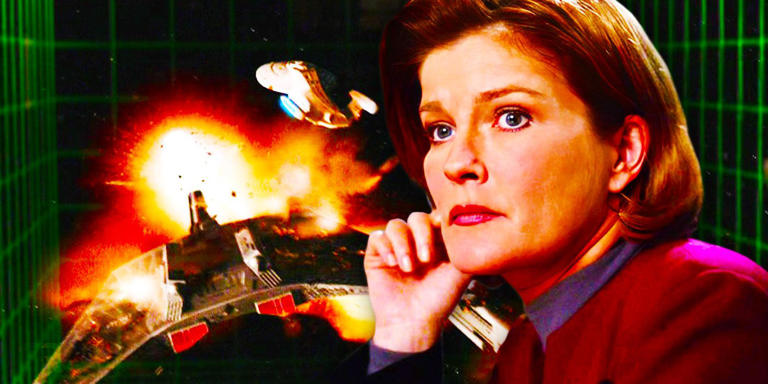

Has there ever been a canon map of the alpha and beta quadrant with the federation, Klingons, Romulans, Breen...? I cant find any information about whether there is a right one or not.
I don't think there was anything in Canon (unless there was some kind of obscure map on a display screen in one of the episodes).
There are some other detailed maps though, and these might be the closest ones to canon maps:
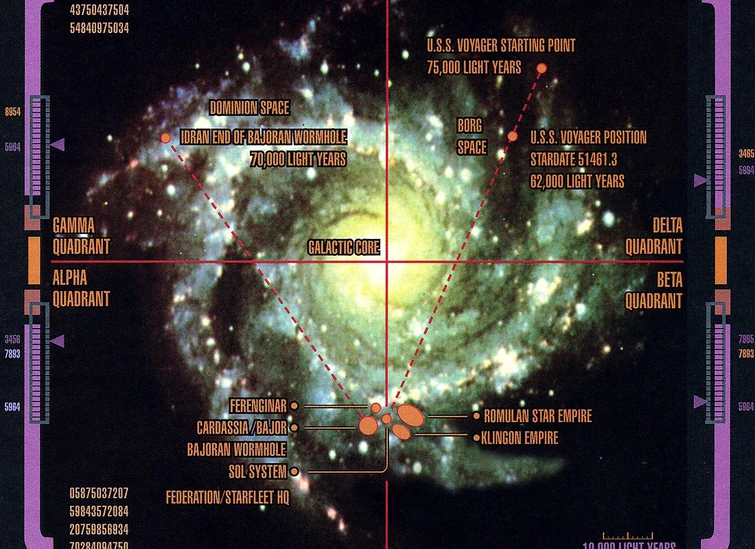
http://blog.trekcore.com/2018/09/weekend-update-star-trek-4-uk-emmy-award-picard-galaxy-map/
http://www.nerdovore.com/2013/01/star-trek-maps.html?m=1
https://www.deviantart.com/kamikage86/art/Star-Trek-Galactic-Territory-Map-801406642
Never saw a canon one
Try the “Star Trek Stellar Cartography” reference guide by Larry Nemecek. It is drawn from canon and has current information up through “Discovery”. It is very artfully done. I highly recommend it!
Apparently there's a map in the Star Trek: Discovery episode "Context is for Kings", but I don't think it's necessarily accurate as a depiction of who controls what territory in other shows.
What do you think?

IMAGES
VIDEO
COMMENTS
The map above is Shakaar's Alpha/Beta map v3.3; a fan-made creation showing the Alpha and Beta quadrants of the Star Trek universe. The map shows both major and minor powers that have appeared in the various series over the years. At the centre is the United Federation of Planets, which borders the major power of the Klingon Empire, Roman ...
The Star Trek galaxy explained that apart from the Romulans and the different versions of the Klingons, the Beta Quadrant's highlight is Vulcan, the native planet of Spock and other members of the Vulcan species.Multiple Star Trek encyclopedias suggest that Vulcan is located in a Sector of the same name within the Beta Quadrant. The 2002 publication Star Trek Charts also estimates Vulcan's ...
The Beta Quadrant was the common designation for one-quarter of the Milky Way Galaxy. It was adjacent to the Alpha and Delta Quadrants. One-quarter of the galactic core was located in this quadrant. (Star Trek: Voyager, Season 7 production art; [1] Star Trek Into Darkness display graphics) Part of the United Federation of Planets was located in the Beta Quadrant, along with the bulk of the ...
Even a subspace transmission (warp 9.9999 with amplification) covers this distance in more than three months. Consequently, only the fact that Earth, the Federation and most of the other empires are located at the frontier between Alpha and Beta quadrant makes it possible that we hear something about other quadrants at all, and it isn't surprising that the two remaining quadrants - Gamma and ...
In stellar cartography, a quadrant is a major region of space encompassing a portion of a galaxy. The Milky Way Galaxy was commonly divided into four equally sized, cubic quadrants, defined by one meridian passing through the galactic core and a second one perpendicular to the first, that also passes through the galactic core. These four quadrants are referred to as the Alpha Quadrant, Beta ...
The Alpha Quadrant was the common designation for one-quarter of the Milky Way Galaxy. It was adjacent to the Beta Quadrant and the Gamma Quadrant. One-quarter of the galactic core was located in this quadrant. (Star Trek: Voyager, Season 7 production art; [1] Star Trek Into Darkness display graphics) In late 24th century interstellar politics and diplomacy, the four great powers in the Alpha ...
The space within the Alpha and Beta Quadrants is excellently rendered, but all of the Delta Quadrant things besides the Borg and Hirogen are far too large (Devore are supposed to control 12 star systems, not a space larger than the federation, for instance).
A brief history of the Alpha and Beta Quadrants, exploring major and minor powers. Based in the Universe of Star Trek, created by Gene Roddenberry. **Please ...
Sci-fi. Star Trek. List of star systems in the Alpha and Beta Quadrants. For a specific list of each quadrant's stars and systems, see the categories listing Alpha and Beta Quadrant star systems. 40 Eridani (in Beta Quadrant) 61 Cygni (in Alpha Quadrant) Aaamazzara Aalad Aarra Aberriz Abraxas Abyss Alpha Accellus...
Instead of going via the Sun as in astronomy, the perpendicular axis in the Star Trek map of quadrants goes through the galactic center. Accordingly, Star Trek's quadrant system is less geocentric than normal cartography. In addition, the Greek letters Alpha quadrant star trek, Beta, Gamma, and Delta are used to denote them in the Star Trek ...
Select a quadrant to view ... Map of the Galaxy Select a quadrant to view ... Buy the book at Amazon.com Star Trek Star Charts: The Complete Atlas of Star Trek ... Star Trek Star Charts: The Complete Atlas of Star Trek =/\\= Today is Stardate 77816.1: E-mail questions or comments ...
on The Map Room blog The Map Room Star Trek. put to print or screen. Star Trek. Memory Alpha. Star Trek Star Trek Star Trek: Deep Space Nine. Learn more. With the third season of 'Star Trek ...
Star Trek: Nautilus. Alpha and Beta Quadrant Politcal Maps. Here are the updated maps of the alpha and and beta quadrants. "North" on the maps is towards the center of the galaxy. On the second map the dark blue sections of space have been traveled but not charted, and the white circles represent those areas which have been well charted and ...
The Beta Quadrant was the common designation for one-quarter of the Milky Way Galaxy. It was adjacent to the Alpha and Delta Quadrants. One-quarter of the galactic core was located in this quadrant. Part of the United Federation of Planets was located in the Beta Quadrant, along with the bulk of the Klingon and Romulan Empires, including their ...
Sci-fi. Star Trek. The Alpha Quadrant is one of the four quadrants of the Milky Way Galaxy, and lies in the "south-west" region of the galaxy map. The Alpha Quadrant is home to a number of major and minor political entities including the United Federation of Planets, whose headquarters is located on Earth on the...
Sci-fi. Star Trek. The following is a list of species from the Alpha and Beta Quadrants. 892-IV native Aaamazzarite Aamaarazan Abdon's species Acamarian Aenar Akaali Alcyone Aldean Algolian Allasomorph Amarie's species Anabaj Ancient One Andoran Andorian Angel I native Angosian Antaran Antedian Antican Antos...
In that sense, the Star Trek quadrant system is less geocentric as a cartographical system than the standard. Also, rather than use ordinals, Star Trek designates them by the Greek letters Alpha, Beta, Gamma, and Delta. The Canadian Galactic Plane Survey (CGPS) created a radio map of the Galaxy based on Star Trek ' s quadrants, joking that "the ...
The Star Trek Star Charts further locate in the Alpha Quadrant the First Federation, Breen, Ferengi, Tzenkethi, Cardassians, Bajorans, Talarians, and Tholians . Star Trek VI: The Undiscovered Country implies that the Alpha/Beta border runs through, or is relatively close to, Federation space.
According to Memory Alpha, the Klingon capital is located in the Beta Quadrant, as is Vulcan, Andoria, and a number of other well-known planets.. So, as one example, much of Sins of the Father was set on Qo'noS, and hence in the Beta Quadrant. Similarly, a number of episodes were set on Vulcan, and The Aenar was set on Andoria.. From the fact that the Enterprise NX-01 visited both Andoria and ...
CommanderErik has put together a map of the major Alpha and Beta quadrant planets and systems for A2. While some points (notably the spelling errors in some system names, and the lack of a screenshot) are in need of an update, for the most part this map is pretty good, without being oversized to the point of extremity.
My head canon fix is the Beta Quadrant is divided behind proper borders of dominant major players. Klingons, Romulans, and Federation types rarely interact in the Beta Quadrant, but the Alpha Quadrant has more mid-tier powers such as the Ferengi and open worlds where meeting denizens of other powers is much more likely, hence why despite the cold war between the UFP and the Romulan Empire O ...
A star chart of the explored areas of the Milky Way Galaxy. The star chart of the explored space in the Alpha and Beta Quadrants depicted the home systems of the three great powers in the quadrant - the Federation, the Klingon Empire, and the Romulan Star Empire.Along with these systems, the home systems of several less significant powers - the Tholian Assembly, the First Federation, and ...
The Federation sits precisely between the Alpha and Beta Quadrants, with the Romulans and Klingons their dominant neighbors on the Beta Quadrant. History suggests that relations between the two ...
Star Trek: Voyager finds familiar things from the Alpha Quadrant in the Delta Quadrant, sparking important questions and connections. Encounter with Ferengi negotiators leads Voyager crew to stop ...
Apparently there's a map in the Star Trek: Discovery episode "Context is for Kings", but I don't think it's necessarily accurate as a depiction of who controls what territory in other shows. (Edited by WoundedDefector)